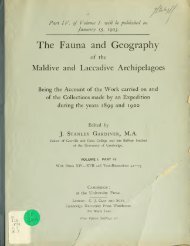Download - WordPress – www.wordpress.com
Download - WordPress – www.wordpress.com
Download - WordPress – www.wordpress.com
Create successful ePaper yourself
Turn your PDF publications into a flip-book with our unique Google optimized e-Paper software.
642 E. C. PUNNETT,but no giant cells are present such as have been figured by Spengel for B. apertus('93, Taf. 7, fig. 18). Except at its anterior end the collar cord is sunk in the perihaemalspaces which embrace it on either side and which may posteriorly reach nearer to the dorsalsurface than the cord itself. The medullary canal <strong>com</strong>municates with the exterior by theanterior and posterior neuropores.The first two dorsal roots are large, close together, and contain nerve fibrils but aredevoid of a lumen. They sf)ring from a <strong>com</strong>mon crest and reach the epidermis where theirnerve fibrils fuse with the nervous layer of the skin. Behind these are two or three smallin<strong>com</strong>plete roots with traces of a lumen but without nerve fibrils.A well-marked j^eripharyngeal space surrounds the oesophagus (PI. XXXIX. fig. 24, pph.)reaching dorsally to where the <strong>com</strong>ua of the nuchal skeleton diverge, and ventrally somewhatanterior to this point.Branchial region. This region is characterized by the small genital pleurae whichare widely separate at their junction with the collar. At the base of the pleurae openthe gill pouches (PI. XLI. fig. l,bp.) which are not provided with ventral caeca. The branchialand digestive portions of the oesophagus are approximately of equal size. Gonads are notfound in the anterior fourth of the branchial region. Not more than six synapticula arepresent on either side of the tongue bars. The post branchial canal is large and the posteriorincipient gill slits open into its ventral portion (PI. XLI. fig. 2, •>;).Genital region. The great bulk of this region is occupied by the gonads in themuch swollen pleurae (PI. XLI. fig. 4). Accessory gonads are not present, but each gonad isroughly two-branched, one division lying on either side of the lateral septum. The genitalpores are found on the edges of the pleurae at the spot where the lateral septum joinsthe epidermis. The single specimen was an adult female.Affinities. The genital pleurae of B. parvulus are relatively smaller than in any othermember of the genus and in this respect it apfiroximates to the genus Glossobalanus. Ofthe members of its own genus it bears most resemblance to B. apertus (Spengel, '93).In both the genital pleurae are widely separate where they join the collar, and this characterserves to distinguish these two species from all the other members of the genus exceptB. misakiensis (Kuwano, '02). Both B. parvulus and B. apertus are small forms withoutaccessory gonads, with a tubular collar cord, and with gill pouches unprovided with a ventralcaecum. The present species however differs from B. apertyts in the following features.B. parvuhisBranchial region but little longer than the collar.B. apertusBranchial region several times as long as collar.Gonads open at edges of genital pleurae.Gonad.s open on inner surface of genitalpleurae.No circular muscles tobody-wall.Feeble circularmusculature.Tongue bars with not more than 6 synapticula.Tongue bars with about10 synapticula.Medullary tube open at eitherend.Medullary tube closed at either end.Giant ganglion cells not found in collar cord.Giant ganglion cells present in collar cord.In B. parvulus also the keel of the nuchal skeleton is more marked, whilst the ventralproboscis coelom has undergone greater reduction. An idea of the relations of these twospecies with the other members of the genus may be gathered from the appended table.






